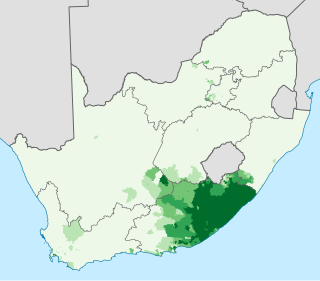Related Research Articles

Hausa is a Chadic language that is spoken by the Hausa people in the northern parts of Nigeria, Ghana, Cameroon, Benin and Togo, and the southern parts of Niger, and Chad, with significant minorities in Ivory Coast. A small number of speakers also exist in Sudan.

Xhosa, formerly spelled Xosa and also known by its local name isiXhosa, is a Nguni language, indigenous to Southern Africa and one of the official languages of South Africa and Zimbabwe. Xhosa is spoken as a first language by approximately 10 million people and as a second language by another 10 million, mostly in South Africa, particularly in Eastern Cape, Western Cape, Northern Cape and Gauteng, and also in parts of Zimbabwe and Lesotho. It has perhaps the heaviest functional load of click consonants in a Bantu language, with one count finding that 10% of basic vocabulary items contained a click.
SothoSesotho, also known as Southern Sotho or Sesotho sa Borwa is a Southern Bantu language of the Sotho–Tswana ("S.30") group, spoken in Lesotho, and South Africa where it is an official language.

Northern Province is one of Zambia's ten provinces. It covers approximately one-sixth of Zambia in land area. The provincial capital is Kasama. The province is made up of 12 districts, namely Kasama District, Chilubi District, Kaputa District, Luwingu District, Mbala District, Mporokoso District, Mpulungu District, Mungwi District, Nsama District, Lupososhi District, Lunte District and Senga Hill District. Currently, only Kasama and Mbala have attained municipal council status, while the rest are still district councils. It is widely considered to be the heartland of the Bemba, one of the largest tribes in Zambia.

Shina is a Dardic language of Indo-Aryan language family spoken by the Shina people. In Pakistan, Shina is the major language in Gilgit-Baltistan spoken by an estimated 1,146,000 people living mainly in Gilgit-Baltistan and Kohistan. A small community of Shina speakers is also found in India, in the Guraiz valley of Jammu and Kashmir and in Dras valley of Ladakh. Outliers of Shina language such as Brokskat are found in Ladakh, Kundal Shahi in Azad Kashmir, Palula and Sawi in Chitral, Ushojo in the Swat Valley and Kalkoti in Dir.
Chitipa District is the northernmost district in the Northern Region of Malawi. The capital is Chitipa. The district covers an area of 4,288 km2, and has a population of 234,927. Chitipa borders fellow districts Karonga and Rumphi, as well as neighboring countries Tanzania and Zambia. The district is divided into five main areas known as Misuku to the east, Kameme to the north, Bulambia right at the centre while Wenya and Nthalire areas are situated to the south.
Sonsorolese is a Micronesian language spoken in Palau, originally on the islands composing the state of Sonsorol, and spreading through migration elsewhere in the country. It is very close to Tobian.

Isoka is a town located in the Muchinga Province of Zambia near the borders with Tanzania and Malawi. It lies on the T2 Road.
Namwanga or Nyamwanga are a Bantu ethnic group native to Momba District in Songwe Region of Tanzania, northeastern Zambia,and Northern Malawi. They speak Nyamwanga or Chinamwanga. In 1993 the Mwanga population was estimated to number 256,000, with 169,000 living in Zambia and 87,000 in Tanzania. At this point, the number of Namwanga people in Malawi is not yet known.
The Mambwe are an ethnic group from Mbala and Senga Hill district of Northeastern Zambia and Kalambo District of Rukwa Region, Tanzania. In 1987 the Mambwe population in Tanzania was estimated to number 63,000. The number of Mambwe in Zambia has not been independently estimated, though the combined number of Mambwe and Lungu people in Zambia was estimated to be 262,800 in 1993.
The Lambya, are an ethnic and linguistic group based along the border of northwestern Malawi,Ileje and in Momba District of Mbeya Region, Tanzania. A minority also exists in Zambia. In 2001 the Lambya population was estimated to number 85,000, including 45,000 in Malawi and 40,000 in Tanzania. The Lambya in Malawi are ruled by Senior Chief Mwaulambya Chieftaincy. The headquarters of the chief is in Chinunkha, Chitipa district.
The Mambwe and Lungu peoples living at the southern end of Lake Tanganyika in Tanzania and Zambia speak a common language with minor dialectical differences. Perhaps half of the Fipa people to their north speak it as a native language. When spoken by the Fipa, it is called "Fipa-Mambwe"; this is also the term for the branch of Bantu languages which includes Fipa and Mambwe-Lungu.
Yao is a Bantu language in Africa with approximately two million speakers in Malawi, and half a million each in Tanzania and Mozambique. There are also some speakers in Zambia. In Malawi, the main dialect is Mangochi, mostly spoken around Lake Malawi. In Mozambique, the main dialects are Makale and Massaninga. The language has also gone by several other names in English, including chiYao or ciYao, Achawa, Adsawa, Adsoa, Ajawa, Ayawa, Ayo, Ayao, Djao, Haiao, Hiao, Hyao, Jao, Veiao, and waJao.
Zambia, officially known as the Republic of Zambia, is a landlocked country in Southern Africa. The neighbouring countries are the Democratic Republic of the Congo to the north, Tanzania to the north-east, Malawi to the east, Mozambique, Zimbabwe, Botswana, and Namibia to the south, and Angola to the west. The capital city is Lusaka, located in the southeast of the country. The population is concentrated mainly around the capital and the Copperbelt to the northwest.

S’gaw, S'gaw Karen, or S’gaw K’Nyaw, commonly known as Karen, is a Sino-Tibetan language spoken by the S'gaw Karen people of Myanmar and Thailand. A Karenic branch of the Sino-Tibetan language family, S'gaw Karen is spoken by over 2 million people in Tanintharyi Region, Ayeyarwady Region, Yangon Region, and Bago Region in Myanmar, and about 200,000 in northern and western Thailand along the border near Kayin State. It is written using the S'gaw Karen alphabet, derived from the Burmese script, although a Latin-based script is also in use among the S'gaw Karen in northwestern Thailand.
The Mwani language, also known by its native name Kimwani, is a Bantu language spoken on the coast of the Cabo Delgado Province of Mozambique, including the Quirimbas Islands. Although it shares high lexical similarity (60%) with Swahili, it is not intelligible with it. It is spoken by around 167,150 people. Speakers also use Portuguese, Swahili and Makhuwa language. Kiwibo, the dialect of the Island of Ibo is the prestige dialect. Kimwani is also called Mwani and Ibo. According to Anthony P. Grant Kimwani of northern Mozambique appears to be the result of imperfect shift towards Swahili several centuries ago by speakers of Makonde, and Arends et al. suggest it might turn out to be a Makonde–Swahili mixed language.
Fwe, or Chifwe, is a Bantu language spoken by 10,000 people along the Okavango River in the Zambezi region of Namibia and in the Western Province in Zambia. It is closely related to Kuhane, and is one of several Bantu languages of the Okavango which have click consonants.
Krongo, also spelled Korongo or Kurungu and known as Dimodongo, Kadumodi, or Tabanya after local towns, is a Kadu language spoken in the South West of the Nuba Mountains in South Kordofan, Sudan.
Fipa is a Bantu language of Tanzania. It is spoken by the Fipa people, who live on the Ufipa plateau in the Rukwa Region of South West Tanzania between Lake Tanganyika and Lake Rukwa. The ethnic group of the Fipa people is larger than the group of Fipa language speakers. On the Tanzanian side, people who speak Mambwe-Lungu may identify as Fipa and consider their language to be a dialect of Fipa. Lungu and Mambwe are also spoken in Zambia where they are considered languages and their speakers are considered to be ethnic groups in their own right, although linguists consider Lungu and Mambwe to be dialects of a single language. There are three dialects: Milanzi, Kwa (Ichikwa) and Nkansi.
Nyiha is a Bantu language primarily spoken in Tanzania and Zambia. The language of the 10,000 speakers in Malawi is different enough to sometimes be considered a distinct language.
References
- 1 2 Namwanga at Ethnologue (18th ed., 2015) (subscription required)
- ↑ Jouni Filip Maho, 2009. New Updated Guthrie List Online
- ↑ Lee S. Bickmore (2000). "Downstep and fusion in Namwanga". Cambridge Journals (Cambridge University Press). Retrieved 2007-02-24.
- ↑ University of Malawi Language Mapping Survey (2006), p. 29.